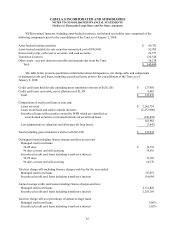Cabela's 2010 Annual Report Download - page 85
Download and view the complete annual report
Please find page 85 of the 2010 Cabela's annual report below. You can navigate through the pages in the report by either clicking on the pages listed below, or by using the keyword search tool below to find specific information within the annual report.75
CABELA’S INCORPORATED AND SUBSIDIARIES
NOTES TO CONSOLIDATED FINANCIAL STATEMENTS
(Dollars in Thousands Except Share and Per Share Amounts)
Property and Equipment – Property and equipment are stated at cost. Depreciation and amortization are
provided over the estimated useful lives of the assets, including assets held under capital leases, on a straight-
line basis. Leasehold improvements are amortized over the lease term or, if shorter, the useful lives of the
improvements. Assets held under capital lease agreements are amortized using the straight-line method over the
shorter of the estimated useful lives of the assets or the lease term. When property is fully depreciated, retired or
otherwise disposed of, the cost and accumulated depreciation are removed from the accounts and any resulting
gain or loss is reflected in the consolidated statement of income. The costs of major improvements that extend the
useful life of an asset are capitalized. Long-lived assets are reviewed for impairment whenever events or changes in
circumstances indicate that the carrying amount of an asset may not be recoverable. Capitalized interest on projects
during the construction period totaled $124, $233, and $2,472 for 2010, 2009, and 2008, respectively. Costs related
to internally developed software are capitalized and amortized on a straight-line basis over their estimated useful
lives. In 2009, the Company removed $39,221 from its property and equipment balance of fully depreciated assets
that were no longer in service. This asset adjustment was based primarily on an analysis of the Company’s property
and equipment records and had no net impact on Cabela’s 2009 consolidated balance sheet, statement of income or
statement of cash flows.
Intangible Assets – Intangible assets are recorded in other assets and include non-compete agreements and
goodwill. At the end of 2010 and 2009, intangible assets totaled $5,342 and $5,756, net of accumulated amortization
of $2,200 and $2,862, respectively. For the fourth quarters of 2010 and 2009, in connection with the preparation
of our consolidated financial statements, the Company completed its annual impairment analyses of goodwill and
other intangible assets. The Company did not recognize any impairment in 2010, but recognized an impairment
of $460 and $1,070 in 2009 and 2008, respectively. The Company recorded impairment and restructuring charges
where projected discounted cash flows were less than the fair value of the reporting unit.
Intangible assets, excluding goodwill, are amortized over three to five years. Amortization expense for
these intangible assets for the next five years is estimated to approximate $593 (2011), $426 (2012), $140 (2013),
$134 (2014), $114 (2015), and $416 (2016 and thereafter). The Company has goodwill of $3,519 in its consolidated
balance sheet at the end of 2010 relating to an acquisition of a Canadian outdoors specialty retailer. The change in
the carrying value of goodwill from 2009 is due to foreign currency adjustments.
Land Held for Sale or Development – Proceeds from the sale of land from development activities are
recognized in other revenue and the corresponding costs of land sold are recognized in other costs of revenue.
Government Economic Assistance – When Cabela’s constructs a new retail store or retail development,
the Company may receive economic assistance from local governments to fund a portion or all of the Company’s
associated capital costs. This assistance typically comes in the form of cash and/or land grants and has been
typically funded by the local government through proceeds from the sale of economic development bonds. The
Company has historically purchased the majority of the bonds associated with its developments. Cash grants
are made available to fund land, retail store construction, and/or development infrastructure costs. Economic
development bonds are typically repaid through sales and/or property taxes generated by the retail store and/or
within a designated development area. Cash and land grants are recognized as deferred grant income as a reduction
to the costs, or recognized fair value in the case of land grants, of the associated property and equipment. Deferred
grant income is amortized to earnings, as a reduction of depreciation expense, over the average estimated useful
life of the associated assets.
Deferred grant income estimates, and their associated present value, are updated whenever events or changes
in circumstances indicate that their recorded amounts may not be recovered. These estimates are determined when
estimation of the fair value of associated economic development bonds are performed if there are related bond
investments. When it is determined that recorded amounts will not be recovered through projected discounted
cash flows, an adjustment is made to reduce deferred grant income, and accumulated amortization on the deferred
























